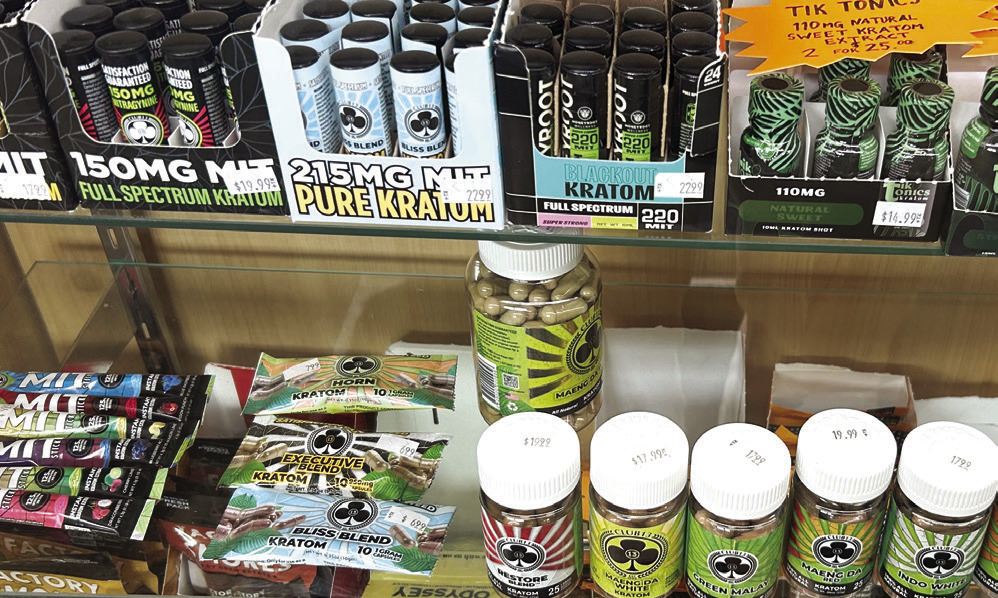Last week, The Community News Brief shared the story of Chad White, who died last year as a result of using Kratom, which is marketed as a 'natural substance' for anxiety and depression, or for use as a 'pick-me-up.' Along with Chad's mother, Lisa Garner, telling her story about her son's death, the medical community is starting to pick up on the dangers of these products, which are openly sold over-the-counter at gas stations, convenience stores or vape shops.
According to the Federal Drug Administration website, on July 29, the agency announced it was taking a step to protect Americans from dangerous, illegal opioids by recommending a scheduling action to control certain products, such as Kratom, under the Controlled Substances Act. Kratom is a tropical tree that is native to Southeast Asia. Products prepared from Kratom leaves are used to self-treat conditions such as pain, coughing, diarrhea, anxiety and depression, opioid use disorder, and opioid withdrawal. An estimated 1.7 million Americans aged 12 and older used Kratom in 2021, according to the Substance Abuse and Mental Health Services Administration.
'The lack of awareness surrounding Kratom is deeply concerning. Despite its growing prevalence, Kratom remains poorly understood within the healthcare community,' shared Tiffany White, a registered nurse and Chad's sister. 'From my experience, many healthcare providers are not familiar with the substance, much less its pharmacological effects or potential risks.'
According to White, one of the key issues is that what's marketed as Kratom and sold at local smoke shops lacks transparency in product content, which is an adulterated formulation making it significantly more potent and bioavailable than what would ever be expected from naturally-derived Kratom.
'Commercial Kratom is simply dirty, unregulated and insufficiently researched,' White explained. 'This gap in knowledge has serious consequences, including missed opportunities for proper screening, inadequate counseling and the under-recognition of potential complications. In emergency situations, such as what happened with my brother, medical personnel are at a disadvantage when it comes to identifying and managing a Kratom overdose.'
Dr. Imran Khan, an emergency room physician at McDonough District Hospital noted that while it's rare to see Kratom overdoses in the ER, there have been many cases of seizures, respiratory depression and altered mental status related to Kratom use.
'This substance can cause psychological dependance and withdrawal, as well as reversible liver toxicity,' Dr. Khan noted.
'However, testing for its use is not common in a medical setting and requires special lab techniques that are often not available in many rural hospitals.'
According to Ashley Martin, psychiatric mental health nurse practitioner at Lakeview Medical and Psychiatric Healthcare in Macomb, within their practice, therapists have had a few patients report using Kratom for pain relief, anxiety or mood disorders.
However, Martin suspects its use is under-reported, much like other 'natural' products. 'People don't realize the risk of OTC products due to the ease of accessibility; therefore, under-reporting and not recognizing its significance during office visits could be potentially harmful,' Martin explained.
'Products labeled 'natural' that are sold over the counter such as Kratom are not safe just because they are plantbased.'
Martin pointed out that over nine years ago, the Drug Enforcement Administration (DEA) announced its intention to temporarily classify Kratom's active compounds as a Schedule I controlled substance, which would have put it in the same category as heroin and LSD. She also noted that the Food and Drug Administration (FDA) has repeatedly warned consumers against using Kratom due to safety concerns like liver toxicity, seizures and addiction. In July 2025, following a recommendation from the Department of Health and Human Services, the FDA requested the DEA to classify 7-hydroxymitragynine (7-OH), a more potent compound found in some concentrated Kratom products, as a Schedule I substance. This targets concentrated items like vapes and gummies, not the traditional natural leaf.
'If someone takes a small dose of Kratom, they will appear to have taken a stimulant — somewhat like taking cocaine — which creates a sudden burst of energy that can result in anxiety, becoming more talkative and social, a decreased appetite and impaired coordination, among other side effects,' Martin said. 'Higher doses can cause euphoria, but can also result in constipation, itching and nausea. The effects of larger doses of kratom are often compared to what happens when someone takes morphine or heroin.'
If someone feels they are, or a loved one is, becoming addicted, Martin said Illinois treatment centers, such as Gateway Foundation and Lincoln Recovery, are treating Kratom addiction.
White added that she had no idea Kratom was slowly killing her brother. Within the last year, he'd had labs drawn and even an echocardiogram, and everything looked fine, she reported. He also seemed fine, his sister said, aside from the headaches and fatigue, which felt easy to chalk up to being a dad of two young kids and working full-time from home.
'My brother was my best friend; we talked every day.
I was even with him several hours the day he died, and I never would have imagined that hug goodbye would be our last,' White shared.
'As an RN, I can't help but feel like I should have seen the signs. That's the hardest part… trying to live with the guilt that I couldn't save him.'












